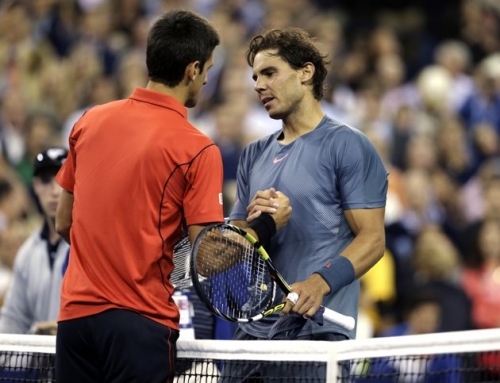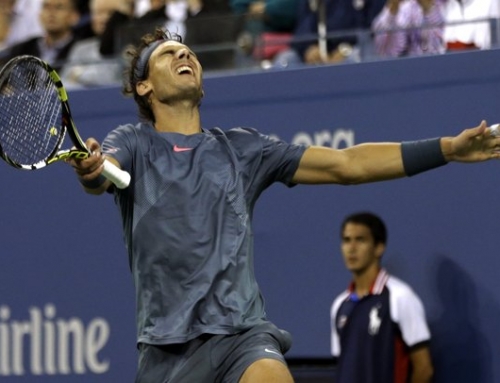 Last year, a feat occurred at the Rogers Cup that had never happened before, at least since the ATP started keeping records. The top 8 seeds reached the quarterfinals. However, only one top four seed won his match, namely, Andy Murray, who ultimately won. Federer was upset by Tsonga, Nadal by del Potro, and Djokovic to Andy Roddick. Of these upsets, the most surprising was Federer’s loss, not only because he had a pretty good head-to-head record against Tsonga, but he also had a huge lead in the third set, and then blew it.
Last year, a feat occurred at the Rogers Cup that had never happened before, at least since the ATP started keeping records. The top 8 seeds reached the quarterfinals. However, only one top four seed won his match, namely, Andy Murray, who ultimately won. Federer was upset by Tsonga, Nadal by del Potro, and Djokovic to Andy Roddick. Of these upsets, the most surprising was Federer’s loss, not only because he had a pretty good head-to-head record against Tsonga, but he also had a huge lead in the third set, and then blew it.
The loss of Nadal to del Potro wasn’t that unusual. Nadal had been off tour for quite a while and was somewhat rusty. Furthermore, del Potro had beaten Nadal earlier in the year. Similarly, Djokovic had lost to Roddick at the Australian Open.
This year, the top 4 men in the world made the semifinals. Although this is less rare, it’s still quite rare for a tournament. It is, I suppose, rare that for the 3 and 4 seed to meet in the finals. To be fair, it’s unusual for us to think of Roger Federer has number 3 in the world. The ESPN commentators pointed out that Novak Djokvic had yet to beat a top 10 player this year and yet, here he was, at number 2 in the world.
Before I talk about the final, let me explain how that happened. Rankings are based on one year of play. So if you played really good last year, that plays a big role in your rankings. Consider that del Potro has played only a handful of tournaments and has basically not played since March. He has failed to defend any points, and yet, it’s taken until this week or so for him to fall out of the top 10, despite inactivity.
It’s just that del Potro won the US Open, reached the finals of the ATP World Tour Final, reached the finals of the Rogers Cup. Big results in big tournaments help. Djokovic also has done well. He reached the semis of the US Open and Wimbledon, reached the quarters of the Australian Open and the French Open. By rights, he should have reached the semifinals of the Australian and French Open, losing both matches due to health issues. Despite not beating the big name players, Djokovic plays solid tennis. And, in any case, he’s barely 100 points ahead of Roger Federer.
Let’s get to the final. By form, that is based on who is playing best, you’d have to pick Andy Murray. He beat Nalbandian easily and beat Nadal in straight sets. The last few matches, Federer has struggled to put away his opponent, nearly losing to both Djokovic and Berdych. The one positive out of both matches is his quick start. In both matches, Federer ran off to a quick lead in the first set and looked like he would win handily only to find both players regaining form and really pushing him. The one negative is his problems breaking serve when he has opportunities.
The one wildcard that makes this match difficult to predict is Murray’s tactics. Murray doesn’t like to play hugely aggressive tennis. In the past, one reason for avoiding this strategy was missing too much. Consider Robin Soderling, who basically pounds the ball hard all the time. He lost to Nadal because Nadal looped the ball back high and gave himself time to recover, and because Nadal is so quick both with his feet and with his hands.
However, for the first time ever, Murray played aggressive tennis against two players: Nadal and Nalbandian. (Aside: you can’t spell Nalbandian without Nadal!). This style served him especially well against Nalbandian who was probably expecting a far more passive Murray and was blindsided by this strategy. Nadal knows, of course, how Murray will play him. Indeed, Murray has even adjusted how he plays Nadal a little since he had his first big victory against him at the US Open in 2008.
Murray used to hit the short angled crosscout forehand to Nadal. This shot was designed to force Nadal to hit his backhand. As good a backhand as Nadal has, he plays far less offensively with it, most of the time. This time around, Murray hit the angle higher up and much deeper and kept Nadal from hitting the forehand. Murray also played the second serve very far in the court, almost hitting a half-volley shot in no man’s land and then retreated back to the baseline. It seemed like Murray wanted to get the ball back as quick as possible to prevent Nadal from getting a first strike on the ball and give him a neutral ball on the second shot by Nadal. Murray took big chances with his forehand and attacked the Nadal backhand by striking hard to the sideline.
Nadal made a few adjustments as well. In particular, Nadal has generally been vulnerable moving to his left to cover the forehand. His usual tactic is to hit the ball quick and hard, and that invariably leads to him hitting the ball in the net. He’s now poking the ball so that it lobs up high with not much pace and trying to get it deep to at least force his opponents to hit one more shot. Fortunately, Murray was able to deal with this shot.
The big question is whether Murray will use this strategy against Federer. When Murray first started having success against Federer, Fed was struggling somewhat with consistency. Keeping the ball in play was one way to induce Federer into missing. However, this strategy has sometimes misfired. When Fed comes out hitting well as he did in Australia and the US Open, Murray has lost a set before adjusting to a more aggressive strategy, and by that time, Fed is rolling and Murray is hoping to get a set somewhere.
Murray has yet to try the Nadal strategy on Federer from the get-go, and it seems he should at least try it out. Federer has shown some vulnerability to power, although he’s the one that usually dishes it out. Berdych used power to almost beat him. Djokovic hit his inside out forehand to great effect last night. Murray is stubborn, but surely he realizes he hasn’t tried playing Federer like this before, and with several losses to him already, he needs to mix things up a bit more.
Murray has one more advantage. Federer has already been given himself an out. Federer nearly had a one hour match that was a gift from Djokovic, but Djokovic forced him to stay on court much longer than Fed wanted, given the circumstances. Since Fed played the late match and since the final is earlier than either semifinals (1:30 Eastern time), Fed will have much less rest than Murray who was done by 5 PM last night and could get to rest much sooner than Federer who probably didn’t get to bed until midnight. Federer has said he’s already banged up, but that he has been that way before, so he would be ready for the finals. Of course, that might just be Fed playing mind games, which he’s not above doing.
Given this, I think the slight edge goes to Murray, although it’s been a while since he’s beaten Federer. Fed has taken the last three matches including the Australian Open, the round robin at the ATP World Tour Finals, and Cincinnati. Murray’s last win was at Indian Wells.



![[Paris] Djokovic finishes post US Open tournaments undefeated with win over Ferrer](https://www.essentialtennis.com/wp-content/uploads/2013/11/20131103nole-500x383.jpg)
![[Shanghai] Djokovic wins the China double, adding Shanghai title to Beijing](https://www.essentialtennis.com/wp-content/uploads/2013/10/20131013nole-500x383.jpg)
![[Shanghai, SF] del Potro upsets Nadal in awesome display of power](https://www.essentialtennis.com/wp-content/uploads/2013/10/20131012delpo-500x383.jpg)

